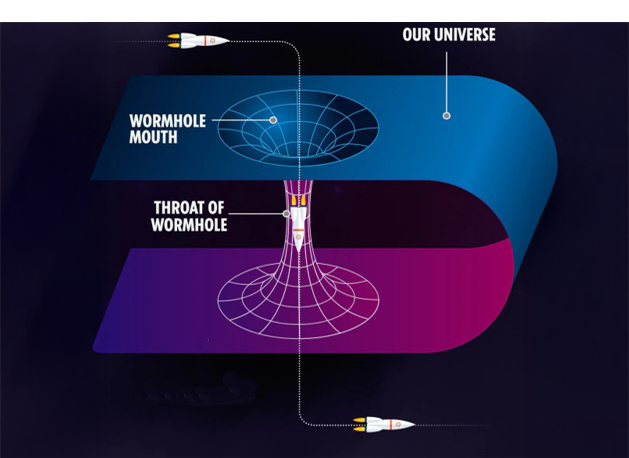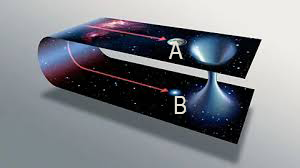Wormholes: Nature's Ultimate Shortcuts

What are Wormholes?
Imagine you're an ant walking on the surface of an apple, trying to get from one side to the other. You could crawl all the way around the apple's surface - or you could tunnel straight through the core for a much shorter trip! That's exactly what a wormhole would be like in space - a cosmic tunnel that connects two distant points in the universe.
Wormholes could theoretically allow you to travel vast distances in space - or even through time - in just seconds. Think of them as nature's ultimate express lanes through the universe, bypassing the normal speed limit of light travel!
Tunneling Through Space-Time
To understand wormholes, you need to think about space and time as one connected thing called "space-time." Einstein showed us that massive objects like stars and planets actually bend space-time, kind of like how a bowling ball makes a dent in a trampoline.
If space-time can be bent, scientists wondered: could it also be folded or even punctured? That's where the idea of wormholes comes from - places where space-time folds back on itself to create a shortcut.
Imagine the universe was 2-dimensional, like a big piece of paper. Now suppose we want to go from point A to another point B far away on the paper. If the paper is not flat but folded, so that points A and B lie above one another, then we could imagine "tunneling" through the page, taking a shortcut through space.

The Geometry/Terminology of Wormholes
- Space-time curvature: Extreme gravity bends space-time into a funnel shape.
- Bridge formation: Two funnels connect at their narrow points.
- Throat creation: The connecting bridge is called the "throat" of the wormhole.
- Two mouths: Each end opens into space at different locations. These are called the "mouths" of the wormhole.
Who Discovered Wormholes?
Albert Einstein's theory of General Relativity tells us that massive objects bend space and time. Picture space-time as a stretched rubber sheet - when you place a bowling ball on it, the sheet curves around the ball. This curvature is what we experience as gravity.
In 1935, Einstein and physicist Nathan Rosen discovered something amazing: under certain conditions, space-time could be curved so extremely that it forms a tunnel connecting two distant regions. They called these theoretical tunnels "Einstein-Rosen bridges," but today we know them as wormholes.
The Exotic Matter Problem
Wormholes sound amazing, but there is a major problem in creating them. Even if wormholes exist, keeping them open would require something called "exotic matter" - a mysterious substance with negative mass or energy.
Matter is "stuff." Everything we can feel and see on Earth is matter, and it's usually in one of three types: solid, liquid or gas.
There are other types of matter that do not behave like normal everyday matter. The types that behave in the weirdest ways are called "exotic matter." One type of exotic matter is matter with negative mass (or energy).
All matter that we know has a positive mass (or positive energy) and is attracted to other matter due to gravity – like an apple falling to Earth. Matter with a negative mass would push other matter away from it. This isn't like antimatter (which has positive energy but opposite charge). Exotic matter would have negative energy, which means:
- Antigravity effects: It would push instead of pull gravitationally
- Negative mass: It would have less than zero mass
- Repulsive gravity: It could prevent the wormhole from collapsing
- Unknown existence: We've never discovered this type of matter
Wormhole Paradoxes
Even if we could create wormholes, they would bring some mind-bending problems. For example, if a wormhole allows time travel, what happens if you go back and prevent your own birth? This called the Grandfather Paradox. Some scientists think the universe has ways to prevent paradoxes, while others suggest multiple timelines.
Quick Facts About Wormholes
- What they are: Theoretical tunnels through spacetime that could connect distant regions of the universe
- Travel time: Could theoretically allow near-instantaneous travel across vast distances
- Stability: Most wormholes would collapse almost instantly without exotic matter to keep them open
- Time travel potential: Could theoretically allow travel to the past, creating grandfather paradox scenarios
- Fiction vs reality: Popular in sci-fi, but real physics makes them extremely unlikely to exist naturally
Wormholes in Thunder Cloud Summer
The portal in our story shares many features with theoretical wormholes:
- Instant transportation: Ben and Cecelia travel across the universe to a new world instantly
- Energy requirements: The supernova and cosmic rays provide the enormous energy needed
- Unstable nature: The portal appears suddenly and disappears just as quickly
- Space-time distortion: The aurora and strange effects suggest severe space-time curvature
- Two-way travel: The characters can return through the same portal
While real wormholes would probably require incredibly advanced technology, the basic physics concepts in the story are based on real scientific theories that physicists study today.
Try it Yourself!
1. The Paper Folding Wormhole
Materials:
- Large sheet of paper
- Pencil or pen
- Ruler
- Scissors
- Colored markers
Instructions:
- Draw two dots on opposite edges of the paper - label one "Earth" and the other "Genova"
- Use the ruler to measure the distance along the paper's surface (the "normal space" route)
- Now fold the paper so the two dots touch each other
- Carefully poke the pencil through both dots at once
- Unfold the paper - you've created a "wormhole" shortcut!
- Measure the thickness of the paper vs. the original distance
What This Shows:
The hole through the paper represents a wormhole - a shortcut through higher dimensions. Instead of traveling along the paper's surface (normal space), you can go directly through the "bulk" (higher-dimensional space).
Think About It: If space really worked like this folded paper, how would it change space travel? What problems might travelers face in a real wormhole?
2. Spacetime Curvature with a Trampoline
Materials:
- Large stretchy fabric or small trampoline
- Several people to hold the edges
- Heavy ball (bowling ball or medicine ball)
- Lighter balls (tennis balls, marbles)
- Two funnels (optional)
Instructions:
- Stretch the fabric tight to represent flat space-time
- Roll light balls across - they travel in straight lines
- Place the heavy ball in the center (this creates curvature like a massive star)
- Roll light balls near the heavy ball - they curve around it!
- Try pushing two heavy balls close together from opposite sides
- If they're close enough, they might create a "bridge" between their curves
Extreme Curvature:
The curved paths show how massive objects bend space-time. In a real wormhole, the curvature would be so extreme that space-time actually folds back on itself, creating a tunnel!
Want to Learn More?
- Kids News - Human-sized wormholes through space and time could be possible
- Space.com - Curious Kids: What is exotic matter, and could we use it to make wormholes?
- NOVA - The Fabric of the Cosmos - Documentary about space-time
- Encyclopedia Britannica - Comprehensive wormhole overview
- Project Gutenberg - Flatland: A Romance of Many Dimensions by Edwin Abbott Abbott